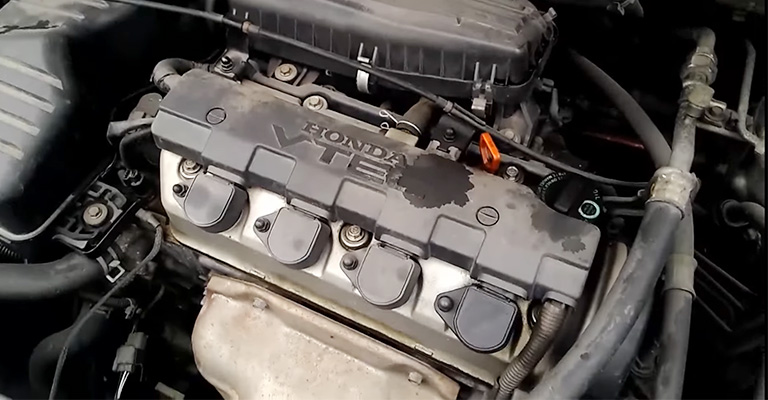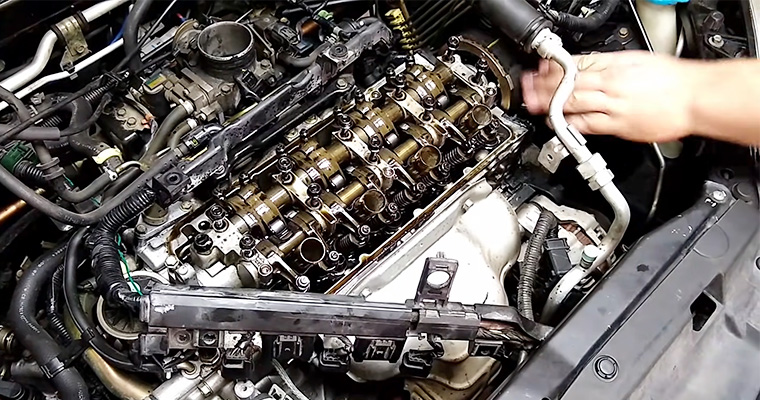The Honda D17A2 engine is a 1.7-liter, 4-cylinder powerplant that was produced by Honda between 2001 and 2007.
It was primarily used in Honda Civics and Acura 1.7 ELs in North America, as well as the Honda Stream and FR-V in other regions.
This engine is known for its compact size and good fuel efficiency, making it a popular choice for compact cars.
The D17A2 is also equipped with Honda’s VTEC (Variable Valve Timing and Lift Electronic Control) technology, which improves performance and efficiency.
In this post, we will take a closer look at the specs and performance of the D17A2 engine.

Honda D17A2 Engine Overview
The Honda D17A2 engine is a 1.7-liter, 4-cylinder engine that was produced by Honda between 2001 and 2007.
It was primarily used in the Honda Civic EX, LX, Si and Acura 1.7 EL in North America, as well as the Honda Stream and FR-V in other regions.
This engine is known for its compact size and good fuel efficiency, making it a popular choice for compact cars.
The D17A2 engine has a displacement of 1,668 cc and a bore and stroke of 75 mm x 94.4 mm. The rod length is 137 mm and the rod-to-stroke ratio is 1.45.
The compression ratio is 9.9:1, which is quite high for a naturally aspirated engine of this size.
This engine is equipped with Honda’s VTEC (Variable Valve Timing and Lift Electronic Control) technology, which improves performance and efficiency.
The VTEC system allows for two different cam profiles to be used, depending on the engine speed. Below 3,200 rpm, the engine uses a low-lift, long-duration cam profile for good low-end torque.
Above 3,200 rpm, the engine switches over to a high-lift, short-duration cam profile for improved high-end power.
In terms of performance, the D17A2 engine is rated at 127 horsepower at 6,300 rpm and 114 lb-ft of torque at 4,800 rpm. The RPM redline is 6,800 rpm and the rev-limiter is set at 7,200 rpm.
These figures are quite good for a naturally aspirated 1.7-liter engine, and the VTEC system helps to improve the power and torque output throughout the RPM range.
The D17A2 engine is also quite fuel efficient, thanks to its small displacement and high compression ratio.
The D17A2 engine uses a SOHC (Single Overhead Camshaft) VTEC valvetrain, with four valves per cylinder, which is a reliable and efficient design.
The fuel control system is OBD-2 MPFI, which stands for On-Board Diagnostics 2 Multi-Point Fuel Injection. This system improves the engine’s performance and reduce emissions.
Overall, the Honda D17A2 engine is a compact and efficient powerplant that is known for its good performance and fuel efficiency.
The VTEC system adds an extra level of performance and efficiency, making it a popular choice for compact cars.
It’s also a reliable engine, which is an important factor to consider when looking for a used car. If you’re in the market for a compact and efficient car that offers good performance, a vehicle with the D17A2 engine is definitely worth considering.

Specification Table for D17A2 Engine
| Specification | Value |
| Engine Type | 4-Cylinder, SOHC VTEC |
| Displacement | 1,668 cc |
| Bore and Stroke | 75 mm x 94.4 mm |
| Compression Ratio | 9.9:1 |
| Power | 127 horsepower at 6,300 RPM |
| Torque | 114 lb-ft at 4,800 RPM |
| RPM Redline | 6,800 |
| Rev-Limiter | 7,200 |
| VTEC Switchover | 3,200 RPM |
| Fuel Control | OBD-2 MPFI |
| Valvetrain | 4 valves per cylinder |
| Rod Length | 137 mm |
| Rod/Stroke Ratio | 1.45 |
Source: Wikipedia
Comparison With Other D17 Family Engines
The D17 engine family is a line of 1.7-liter, 4-cylinder engines that were produced by Honda. The D17A2 engine is just one member of this family, and there are several other variations of the D17 engine that have been used in different Honda and Acura models.
One of the main differences between the D17A2 engine and other members of the D17 family is the power output.
The D17A2 engine is rated at 127 horsepower at 6,300 RPM and 114 lb-ft of torque at 4,800 RPM, which is considered to be a good output for a naturally aspirated 1.7-liter engine.
Other members of the D17 family may have different power and torque outputs, depending on the specific application.
Another difference between the D17A2 engine and other D17 engines is the valvetrain. The D17A2 engine is equipped with Honda’s VTEC (Variable Valve Timing and Lift Electronic Control) technology, which allows for two different cam profiles to be used depending on the engine speed.
Other D17 engines may not have VTEC technology, or may have a different type of variable valve timing system.
The D17A2 engine also has a high compression ratio of 9.9:1 which can make the engine more fuel efficient but also more sensitive to lower octane fuel.
Other D17 engines may have different compression ratios, depending on the specific application.
In summary, the D17A2 engine is just one member of the D17 engine family, and there are several other variations of this engine that have been used in different Honda and Acura models.
Some of the main differences between the D17A2 engine and other members of the D17 family include power output, valvetrain and compression ratio.
Comparison With Other D17 Family Engine Like D17A1 and D17A5
The D17A1 and D17A5 are both versions of the Honda D17 engine. The D17A1 is a 1.7L SOHC i-VTEC engine found in the 2001-2005 Honda Civic EX, while the D17A5 is a 1.7L SOHC i-VTEC engine found in the 2006-2011 Honda Civic.
The main difference between these two engines is their power output. The D17A1 produces 126 horsepower and 114 lb-ft of torque, while the D17A5 produces 114 horsepower and 107 lb-ft of torque.
Additionally, the D17A1 features Honda’s i-VTEC system, which provides improved fuel efficiency and performance.
Both engines are reliable, efficient and known for their longevity. However, the D17A1 is generally considered to be a more powerful and sportier option than the D17A5.
What Car Did the D17A2 Come in?
The D17A2 engine was primarily used in the 2001–2005 Honda Civic EX (US only), 2001–2005 Honda Civic LX (Europe), 2001–2005 Honda Civic Si (Canada only).
2001–2005 Acura 1.7 EL (Canada only), 2000–2007 Honda Stream 1.7 (Japan) and 2004-2007 Honda FR-V 1.7 (Europe).
What Are the Issues and Problems With Honda D17A2 Engine?
The Honda D17A2 engine, which was used in the 2001-2005 Honda Civic, is known for having a number of issues.
One of the main issues is that it does not respond well to bolt-on upgrades, such as intake, header, and exhaust systems, which can only provide a small increase in horsepower.
Another issue is that the engine is not built to withstand high levels of power and pressure, which can lead to problems with the internals, and even the engine block.
Also, the intake manifold is made of plastic which can crack over time, causing vacuum leaks and other issues.
Additionally, the D17A2 is considered to be less efficient than other Honda engines and the ECU is considered to be restrictive.
Overall, the D17A2 engine is not well-suited for high-performance applications and is generally considered to be a low-performance engine.
Upgrades and Modifications for Honda D17A2 Engine
For a 2001 Honda Civic EX Coupe with a D17a2 engine, some recommended upgrades to increase power within a budget of $2300 include:
- Stage 1 or Stage 2 CAM (with spring kit for Stage 2)
- Intake headers and exhaust
- K-Pro engine management system
- Replacing the rear sway bar with one from a 2005-2006 RSX Type S
- Replacing the timing belt when replacing the CAM
It’s important to note that these are just suggestions and it’s best to do further research and consult with a professional mechanic before making any upgrades to your vehicle.
Additionally, keep in mind that these upgrades will not result in “crazy horsepower,” but will provide some increase in power and performance.
Other D Series Engines-

Leave a Reply